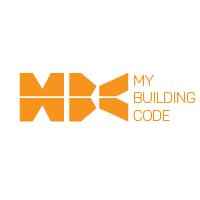Solar panels have proven to be a reliable and cheaper source of energy supply. This is the reason why many more Kenyans are opting to go solar. Previously, the technology needed to convert solar into useable energy used to be quite expensive. However, over the years, we’ve had major technological advancements that have resulted in reduced prices for solar energy.
Kenya lies in the equatorial zone receiving plenty of sunshine all year round. This makes solar a very viable source of energy. If you were thinking of making the switch to solar, here is all the information you need:
- Types of Solar Panels
- How Solar PV Systems Work
- The Different Solar PV Systems and their associated costs
Types of Solar Panels
There are two types of solar panels:
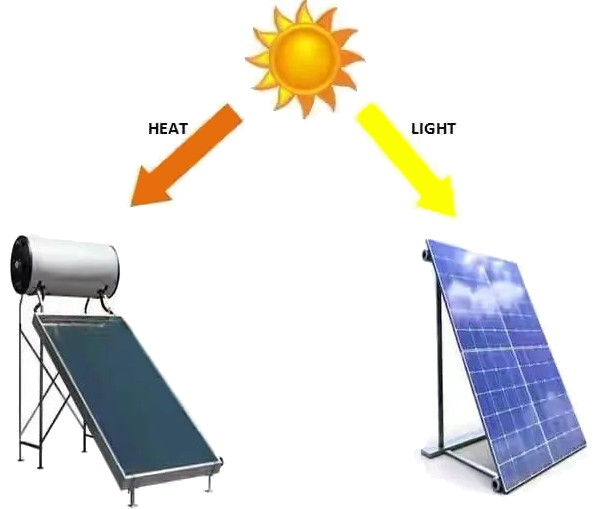
1. Solar Thermal Panels
Solar Thermal is usually used for water heating. It’s a simple technology with three key components:
- Collectors: These are the solar thermal panels mounted on your roof. They absorb sunlight and transfer its heat to a fluid. Flat plate collectors and evacuated/vacuum tubes are the most popular types of collectors. The vacuum tube is more efficient in that it works on the thermos principle: therefore very little heat is lost.
- Pump & Controller: The pump ensures the transfer fluid is circulated between the collectors and the water cylinder efficiently.
- Water Cylinder: the panels on your roof are the collectors of sunlight, thus heating up the liquid in the tubes which is then transported into your cylinder ready for use.
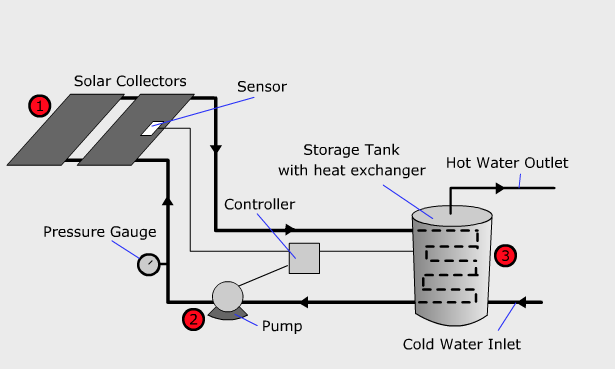
Pricing of solar water heating systems
The cost of installing a solar thermal/ water heating system will depend on the brand and the type of solar water heater, i.e. whether it’s flat plate or evacuated tubes, pressurized or non-pressurized system. The prices range from Ksh 50,000 (USD 425) to an upwards of Ksh 200,000 (USD 1,700).
Note: Installation of Solar water Heaters in Kenya is guided by the Energy and Petroleum Regulatory Authority (EPRA), thus it is important that your installation is handled by an individual with the certifications required by EPRA.
2. The Photovoltaic solar panel (Solar PV)
Solar PV converts sunlight into electricity and can be used to power appliances. Read more about how the solar PV panels work here.
The Solar PV has a higher capital cost than solar thermal. Solar PV also requires larger area of space for installation compared to solar thermal.
Still, the solar PV has a big advantage over solar thermal in that it generates electricity. This allows solar PV owners to sell excess electricity back to the grid and generate a sustainable second income.
The choice between the two will depend on your needs. But we’ve seen many households opting to install both types of solar, utilizing the solar thermal panels for hot water and the solar PV for electricity generation.
How Solar PV Systems work
We’ve already explained how the solar thermal panels work so for the rest of the article we shall focus mostly on solar PV system and its various components.
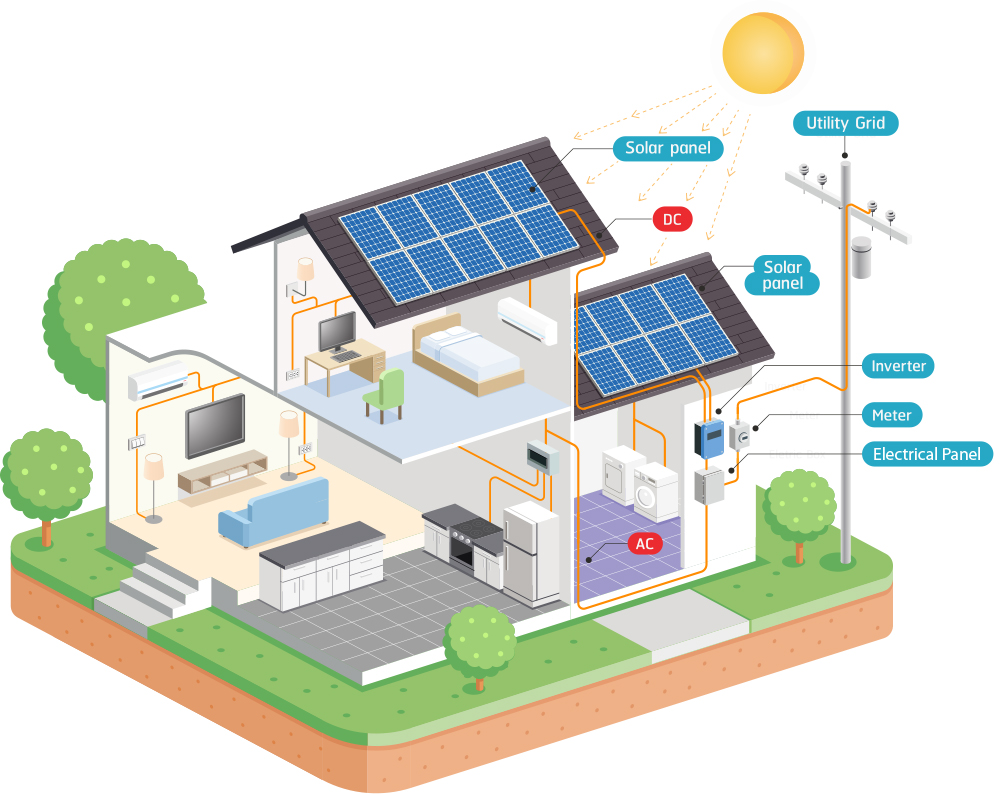
The Solar Module
The Solar PV panels, also referred to as solar module, is made of photovoltaic (PV) cells. Solar radiation emitted by the sun is absorbed by the PV cells when the sun shines directly on them.
Most PV cells have two layers of semi-conductor material, one positively charged and one negatively charged. When light shines on the semi-conductor the electric field across the junction between these two layers causes electricity to flow, generating direct current (DC).
Note: Solar PV electric panels do not require bright sunlight in order to operate, meaning you can still generate electricity on cloudy days. However in general, the greater the intensity of light the higher the flow of electricity
Inverter
Direct Current (DC) needs to be converted into alternating current (AC) so it can be used in a domestic building; this is performed by an inverter. Once converted, the AC current is fed into the electricity supply for use in the home, with any surplus electricity fed back into the national grid.
Solar Battery
It is important to realize that you can only use your free solar electricity when it is being generated – but if you invest in solar batteries you’ll be able to store power for use in the evenings and at night when the panels are not producing electricity.
Charge Controller
The charge controller serves as a current and/or voltage regulator. It ensures that the solar batteries are not overcharged during the day, and that the power doesn’t run backwards to the solar panels overnight and drain the batteries. Some manufacturers put the charge controller and inverter into one thing for simplicity.
Load, Cabling and Connections
In solar terminology, the term “load” refers to the power consumption of the device(s) that are being used in the system. Understanding your loads is critical to maintaining a well functioning power system.
The loads will determine the size of cables that will be used. Cabling for solar done wrong will most definitely burn your house down. The right size of cable from PV to charge controller, and from charge controller to battery is absolutely necessary.
The way they are connected is solar panel to charge controller to battery + charge controller to DC loads + charge controller to inverter to AC loads. And that’s what a solar system is.
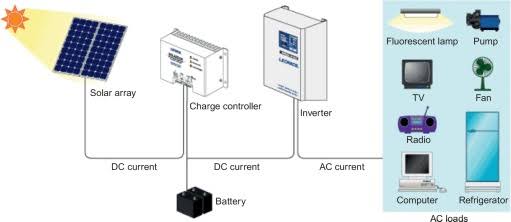
The different Solar PV systems and their associated costs.
Plug and Play Solar Kits
These are relatively inexpensive kits capable of providing lighting and power for AC & DC applications anywhere. They come ready to use, with preinstalled accessories: you just just plug and play.
Their installation costs are minimal since once you purchase, you can either ask for someone to put it on your roof or do it yourself.
The cost for the kits will vary depending on the accessories and payment method. A spot check across various manufacturers show the average retail price of a simple PV system with solar panel, battery, a couple of light bulbs, radios and torch will range between Ksh 35,000 (USD 300) – Ksh 45,000 (USD 385). If the accessories include a TV etc, the price will be higher.
Some sellers offer a ‘Pay-As-You-Go’ financing model where you pay a deposit and monthly installments.
The main disadvantage with these kits is that it comes attached to its own loads i.e. bulbs, TV etc. You can’t add your own to the system. This is why some people opt for Component Based Systems (CBS).
Component Based Systems
For CBS you buy the components separately and they are assembled to form a household solar system like the one we described here.
For CBS installation, you’ll need to involve a solar practitioner who is licensed by the Energy and Petroleum Regulatory Authority (EPRA)- the Kenya Energy Regulator. You van verify the practitioners license from the EPRA website. Incase of issues, you can lodge a complaint with EPRA and they’ll send an inspector.
It is not recommended that you buy the solar panel and other components off the shelf then just connect them together. EPRA technicians need to design the system for you based on the loads you want to be powered.
The cost of installing a CBS, Solar PV system will depend on the loads, size of the inverter and size of the battery. The price on average typically starts from Ksh 90,000 (USD 770) for a 2KVA Inverter, 100Ah Battery that will be sufficient for lighting and WIFI needs running on single phase power. The more the loads the higher the price.
Note: Powering all loads you have with solar might be costly. A good technician will advise you to start with the crucial loads. This will be more affordable as opposed to doing the whole house.
Got any questions regarding solar? Type below in our comments section.
